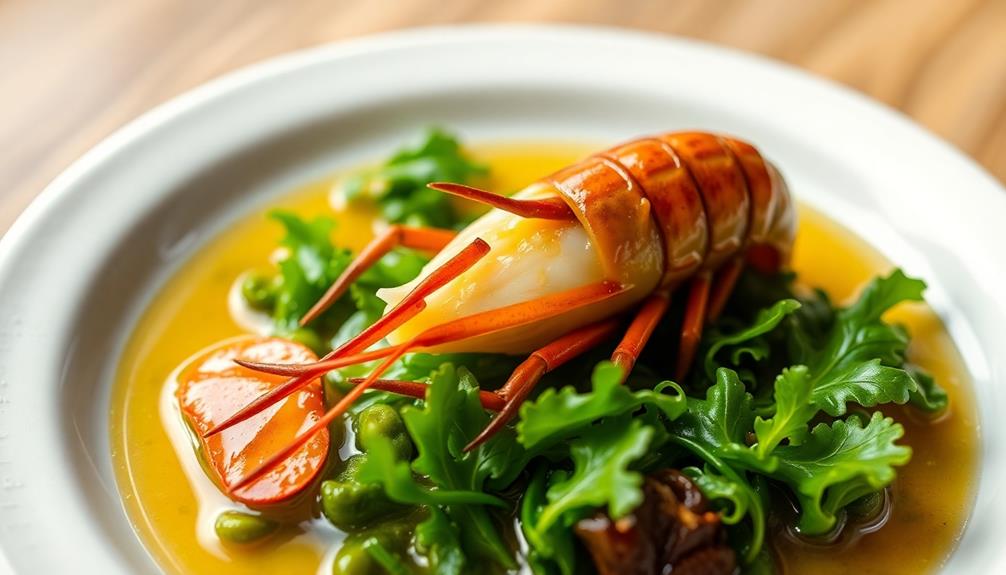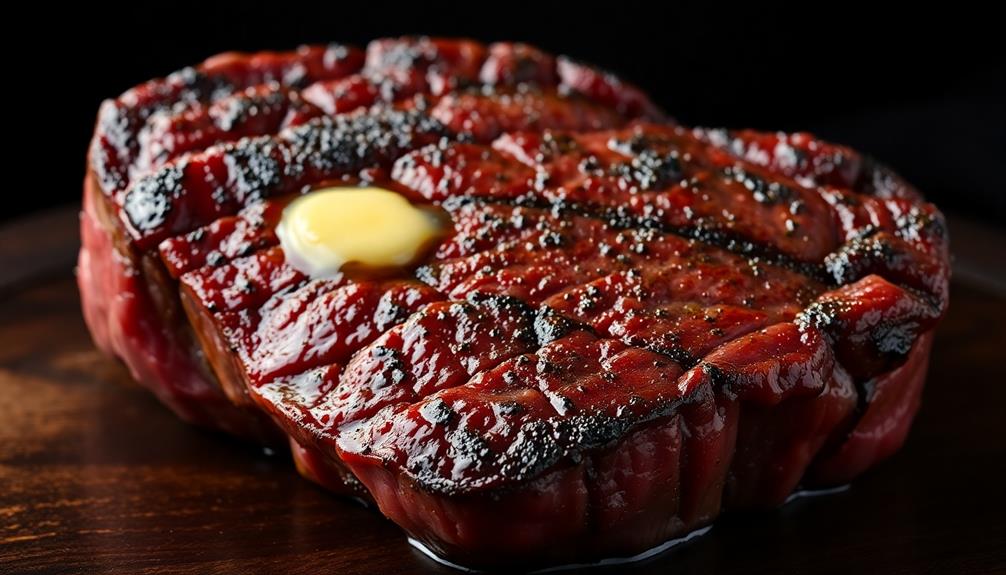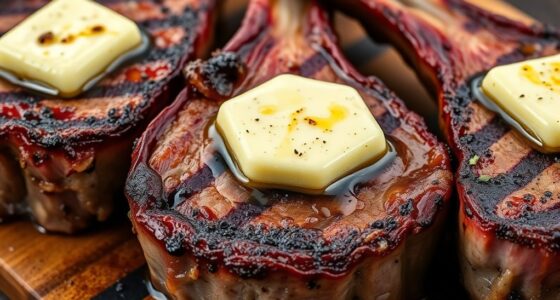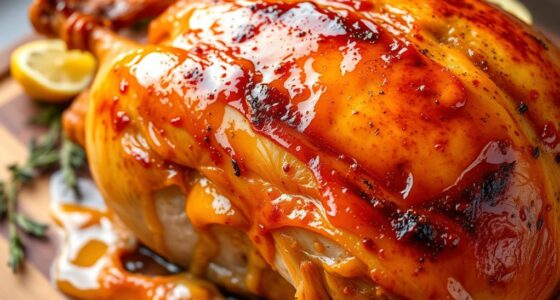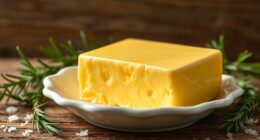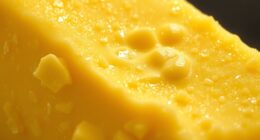Elevate your culinary skills and impress guests with the decadent delicacy of butter-poached lobster, a signature dish from high-end restaurants. This method showcases the sweet, tender meat by gently poaching it in aromatic, clarified butter. You'll start by cracking the shells for easy access, then slowly simmer the lobster, basting it frequently to infuse the rich, buttery flavor. Finish by serving the vibrant red lobster with a bright, herbaceous compound butter that melts over the top. The result is a luxurious, restaurant-quality meal you can recreate at home. Dive deeper into the steps to master this showstopping dish.
Key Takeaways
- Crack lobster shells using kitchen shears or a lobster cracker to allow easy meat extraction and enhance flavor infusion during poaching.
- Gently simmer the lobster pieces in simmering butter for 8-10 minutes until the meat turns opaque, avoiding stirring to maintain a gentle poach.
- Baste the lobster frequently with the poaching butter to ensure even cooking and a rich, vibrant red color.
- Serve the butter-poached lobster with a compound butter made from softened butter, minced herbs, lemon juice, salt, and pepper for added flavor.
- Garnish the dish with fresh herbs like dill, parsley, and chives to enhance the presentation and complement the sweet, buttery lobster.
History
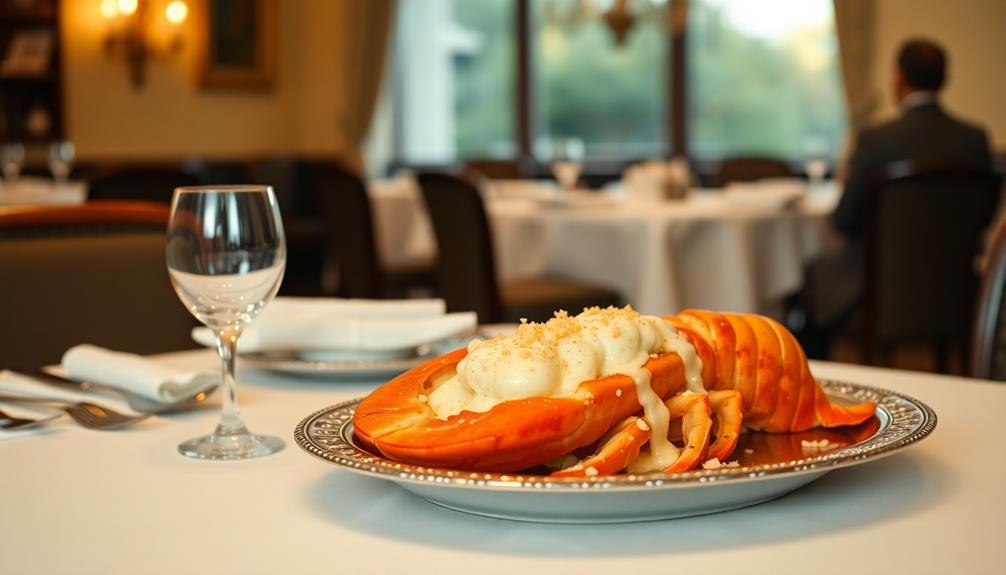
The origins of butter-poached lobster can be traced back to the early 20th century, when resourceful chefs sought to elevate the humble lobster dish.
Recognizing the inherent richness and delicate flavor of this seafood treasure, they experimented with various cooking techniques to showcase its best qualities.
The breakthrough came when someone had the brilliant idea to gently poach the lobster in a bath of melted, clarified butter.
This simple yet ingenious method allowed the natural sweetness and tender texture of the lobster to shine, while the butter provided a luxurious, velvety backdrop.
As word of this culinary revelation spread, butter-poached lobster became a signature dish in high-end restaurants, delighting diners with its extraordinary taste and tender, succulent morsels.
Today, home cooks can recreate this restaurant-quality lobster experience by following the same time-honored technique, elevating their meals to new heights of indulgence and flavor.
Recipe
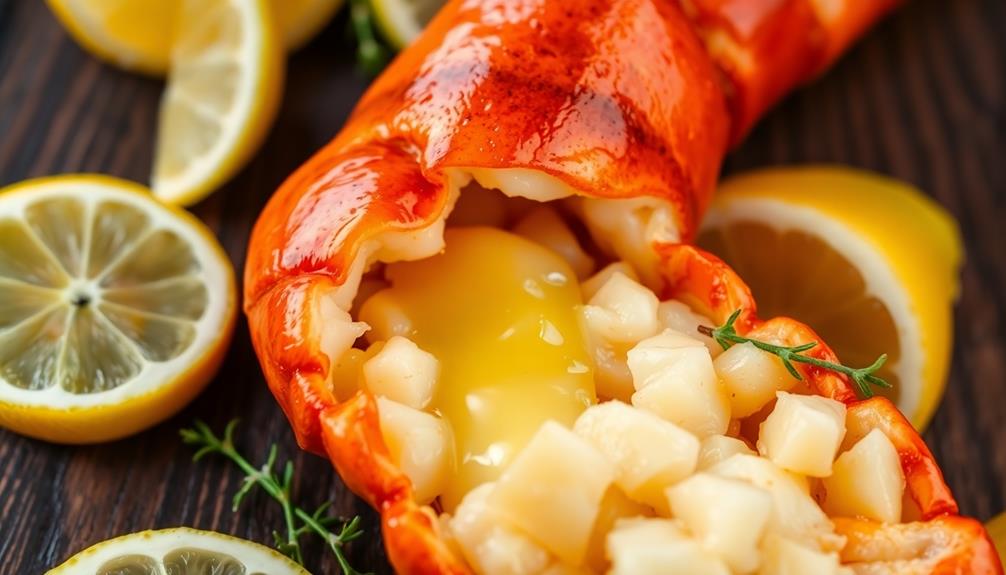
Butter-Poached Lobster is a decadent and luxurious dish that showcases the sweet, tender meat of the lobster in a rich, creamy sauce. The gentle poaching in melted butter ensures the lobster remains juicy and flavorful, while the simplicity of the preparation allows the natural taste of the seafood to shine.
This recipe is perfect for special occasions or when you want to treat yourself to a truly indulgent meal. The velvety texture of the butter-poached lobster pairs beautifully with a variety of accompaniments, from fluffy mashed potatoes to a crisp green salad.
Ingredients:
- 4 (1 1/2-pound) live lobsters
- 1 cup unsalted butter, cubed
- 2 tablespoons freshly squeezed lemon juice
- Kosher salt and freshly ground black pepper, to taste
Directions:
Bring a large pot of salted water to a boil. Add the lobsters and cook for 2-3 minutes, or until they begin to turn bright red. Remove the lobsters from the water and let cool slightly. Twist off the claws and tails, and crack the shells to remove the meat.
In a large saucepan, melt the butter over low heat. Gently add the lobster meat and poach in the butter for 10-12 minutes, or until the meat is cooked through and tender. Stir in the lemon juice and season with salt and pepper to taste.
Tips:
When selecting the lobsters, look for ones that are lively and have intact shells. For the best texture, avoid overcooking the lobster meat.
Serve the butter-poached lobster immediately, while the meat is still warm and the butter is creamy. Enjoy this luxurious dish with a glass of crisp white wine or champagne.
Cooking Steps
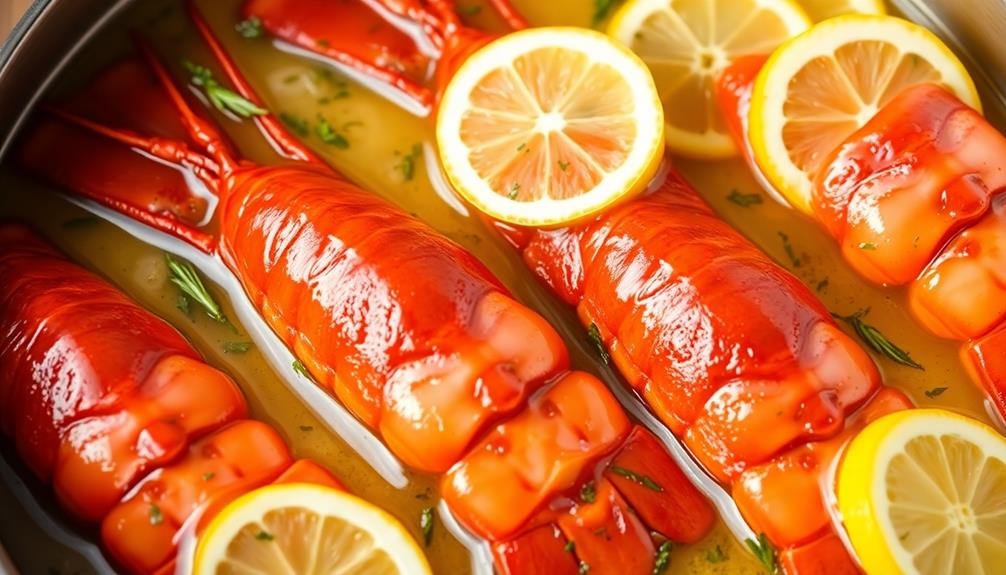
First, you'll want to crack the lobster shells beforehand to make it easier to access the meat.
Then, gently simmer the lobster in that delicious butter, making sure to baste it frequently so it soaks up all that rich flavor.
Step 1. Crack Lobster Shells Beforehand
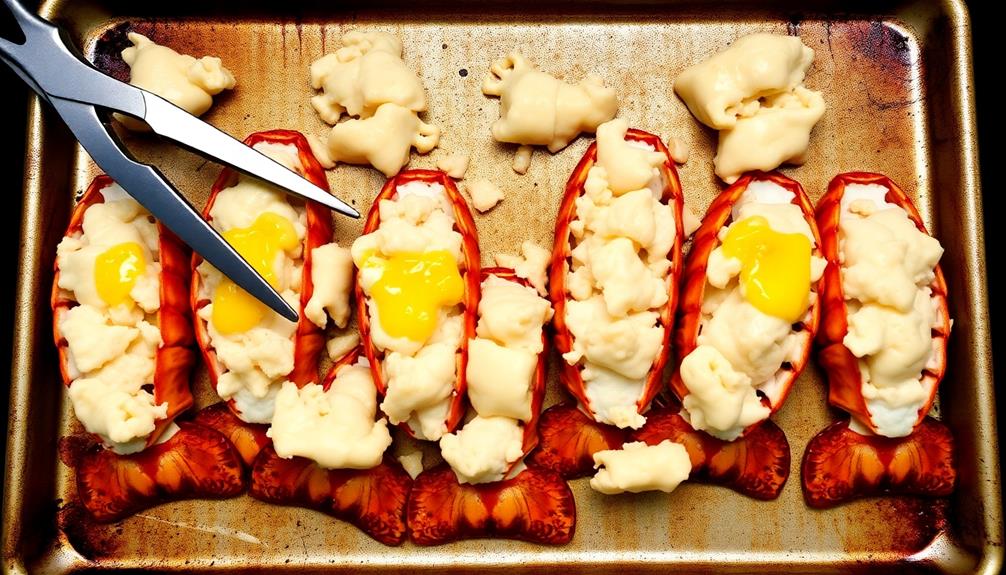
To start, crack the lobster shells beforehand using a sturdy pair of kitchen shears or a lobster cracker. This step makes it much easier to extract the meat later on.
Gently squeeze the body shell to locate the joints, then snip along the seams to split the shell in half. For the claws, place them on a cutting board and use the shears to cut through the hard outer shell. Be careful, as the shells can be quite sharp.
Once the shells are cracked, you'll be able to easily remove the tender lobster meat in one piece when it's time to serve. This prep work may seem tedious, but it's worth it to enjoy that sweet, buttery lobster flavor.
Plus, pre-cracking the shells allows you to fully immerse the lobster in the rich poaching liquid for maximum flavor. With the shells split, you're ready to move on to the next step in creating your luxurious butter-poached lobster dish.
Step 2. Gently Simmer Lobster in Butter
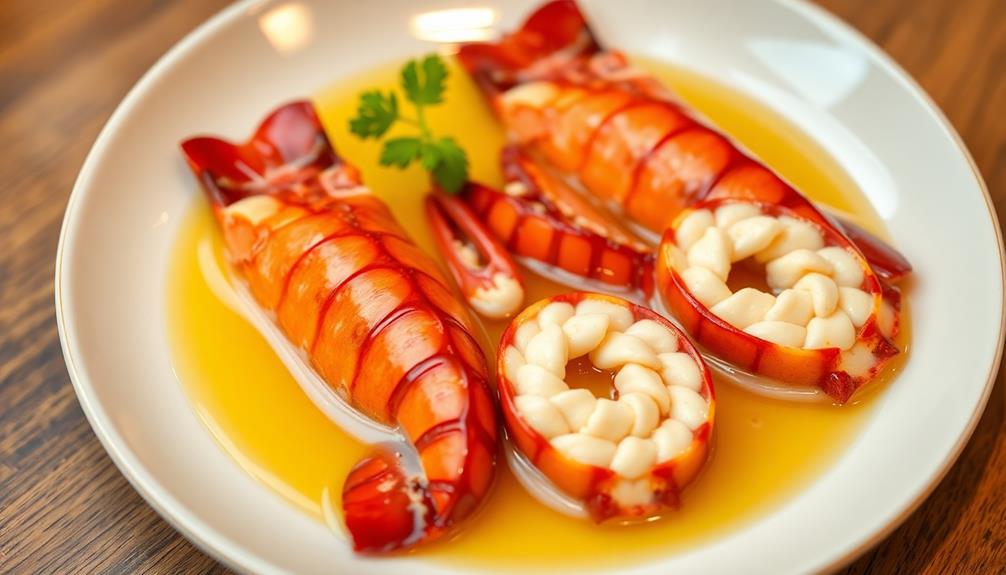
With the shells cracked, you can now gently simmer the lobster in the rich butter mixture.
Carefully lower the lobster pieces into the simmering butter, ensuring they're fully submerged. The gentle heat will slowly cook the lobster, infusing it with the luxurious, velvety butter flavor.
Resist the urge to stir or move the lobster – let it gently poach, untouched, for 8 to 10 minutes. You'll know it's ready when the meat turns opaque and sweet-smelling.
Resist the temptation to overcook, as the lobster can quickly become rubbery.
Use a slotted spoon to carefully transfer the butter-poached lobster to a plate or serving dish. Spoon some of the flavorful butter over the top, allowing it to drip down and coat the meat.
Savor the tender, buttery morsels, relishing in the restaurant-quality lobster you've created in your own kitchen.
Step 3. Baste Lobster With Butter Frequently
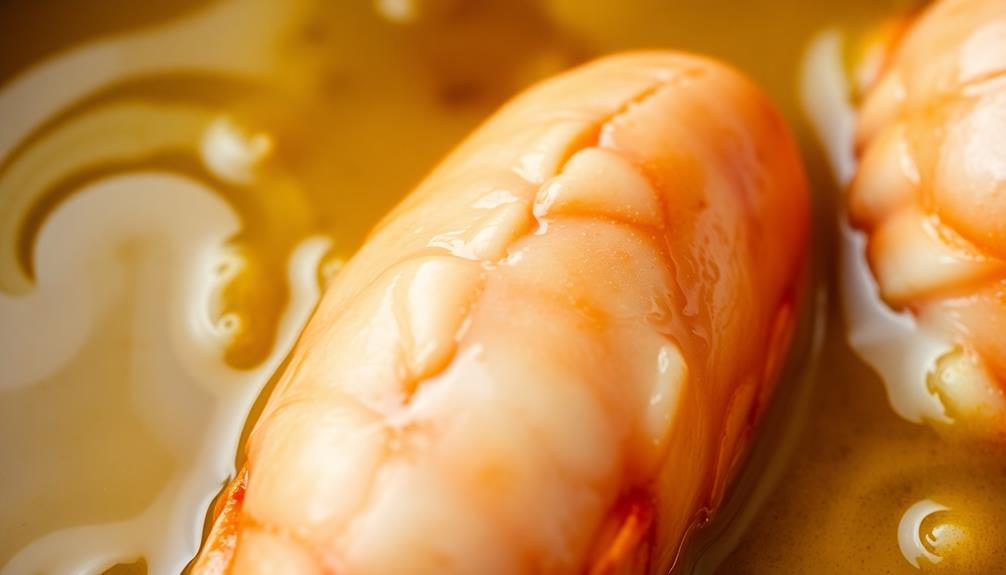
Continuously basting the lobster with the fragrant butter is the key to achieving a perfectly succulent and evenly cooked texture. As the lobster simmers gently in the butter, use a large spoon to frequently ladle the melted butter over the meat.
This basting process helps the lobster cook evenly, infusing it with the rich, buttery flavor. Butter, known for its ability to elevate culinary creations, ensures that each bite of lobster is luxurious and satisfying.
Be sure to baste the lobster every minute or so, moving the spoon carefully to cover the entire surface. You'll see the lobster gradually turn a vibrant red as it cooks. The butter should maintain a gentle simmer, not a rapid boil, to prevent the delicate meat from overcooking.
For more on how butter enhances flavor in savory dishes, check out savory and flavorful infusions. Baste with confidence, letting the aromatic butter caress every inch of the lobster.
This simple yet essential step ensures the lobster emerges from the pan moist, tender, and bursting with buttery goodness in every bite.
Step 4. Serve Lobster With Compound Butter
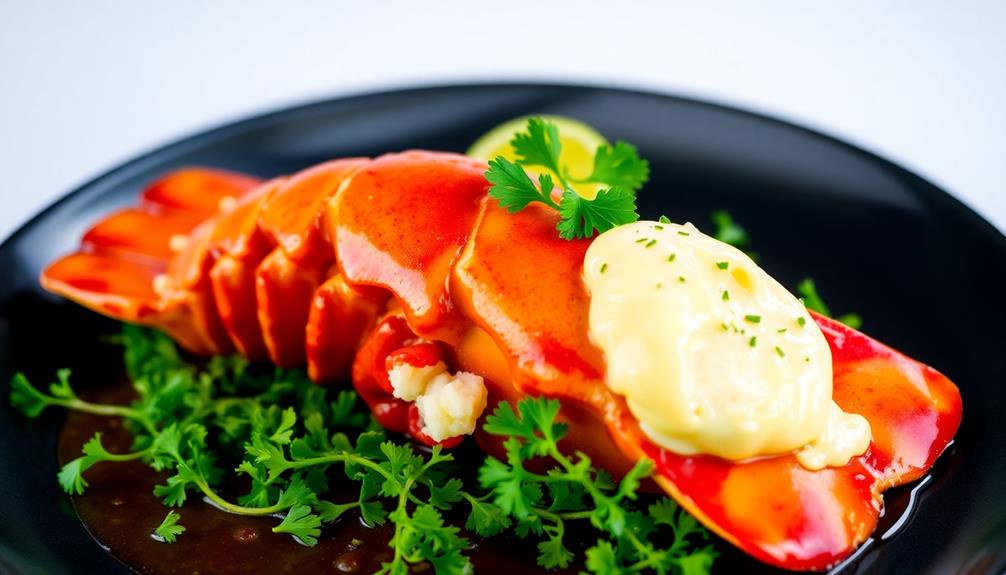
After the lobster has been perfectly cooked and basted with the fragrant butter, it's time to serve it alongside a delightful compound butter. This extra touch adds a layer of flavor that elevates the dish to new heights. Using butter's creamy texture and rich flavor, the compound butter enhances the overall experience.
To make the compound butter, simply mix together softened unsalted butter, minced fresh herbs like chives or parsley, a squeeze of lemon juice, and a pinch of salt and pepper. Stir everything together until well combined.
Roll the flavored butter into a log, wrap it in parchment paper, and chill it in the fridge until firm.
When ready to serve, place a generous slice of the compound butter on top of the piping hot lobster. As the butter melts, it will drizzle over the meat, infusing each bite with vibrant, herbaceous notes.
The cool, creamy butter provides a delightful contrast to the tender, buttery lobster. Serve immediately, and enjoy this restaurant-worthy lobster dish in the comfort of your own home.
Step 5. Garnish With Fresh Herbs
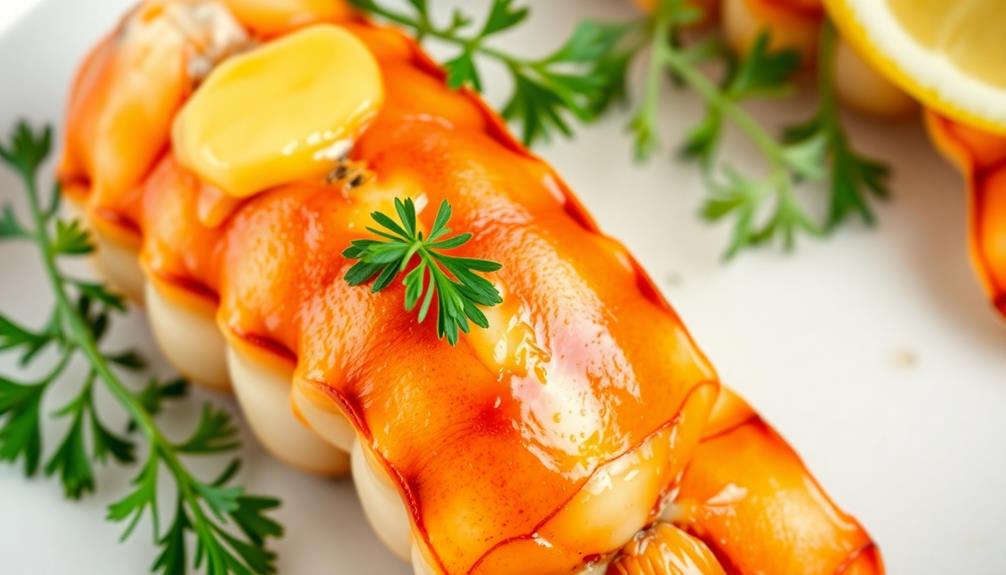
Garnish the perfectly poached lobster with a vibrant blend of fresh herbs. Snip a generous amount of tender dill, lively parsley, and aromatic chives, then scatter them over the glistening meat. The herbs' verdant hues and delicate flavors will complement the sweet, buttery lobster beautifully.
Carefully arrange the garnished lobster on a serving platter, allowing the bright green accents to frame the dish. The contrast of the vibrant herbs against the pale, succulent lobster creates a visually stunning presentation.
Invite your guests to savor the interplay of flavors, with the herbaceous notes dancing across their palates. As they enjoy each bite, encourage them to pause and appreciate the care and attention that went into crafting this exceptional dish.
The delicate balance of the butter-poached technique and the fresh, fragrant herbs elevates the humble lobster into a true culinary masterpiece.
Final Thoughts
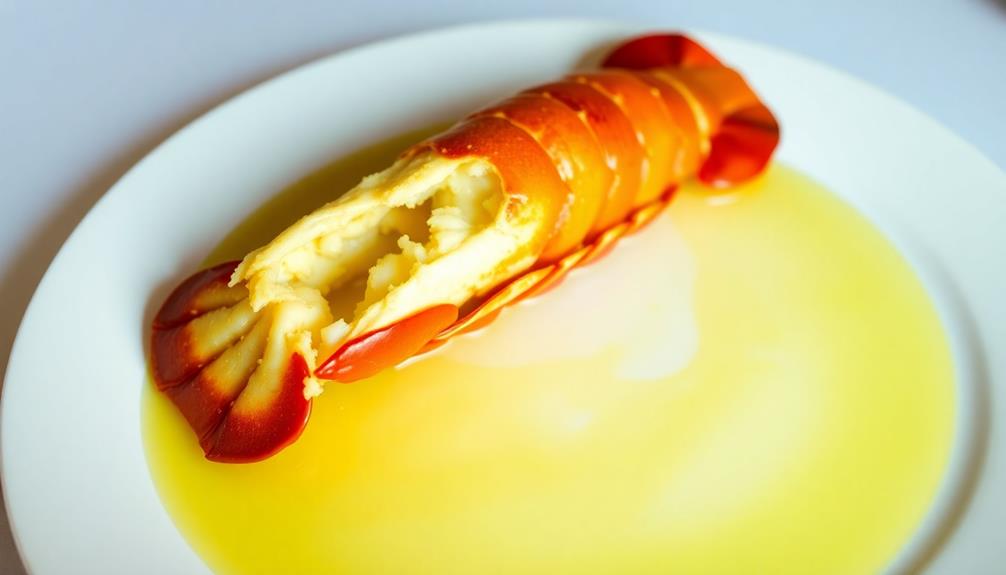
With the butter-poached lobster now complete, you can savor the delicate flavors and luxurious texture. The gentle poaching in rich, melted butter has transformed the lobster into a decadent delight. Each bite offers a burst of sweet, succulent meat complemented by the silky, aromatic butter.
As you take your first taste, pause to appreciate the care and attention that went into preparing this dish. The precise temperature control and patient basting have resulted in a lobster that's perfectly cooked – tender yet firm, with a tender, juicy interior and a delicate, slightly browned exterior.
This butter-poached lobster is a true showstopper, worthy of any special occasion or elegant meal. With its luxurious presentation and exceptional flavor, it's sure to impress your guests and leave them craving more.
Savor every morsel and bask in the satisfaction of creating a restaurant-quality dish in your own home.
Frequently Asked Questions
What Is the Best Type of Lobster to Use?
For the best lobster, you'll want to use fresh, live Maine lobsters. They have a sweet, delicate flavor that's perfect for butter-poaching. Their firm, juicy texture makes them the ideal choice for this preparation.
How Long Can the Poached Lobster Be Stored?
You can store the poached lobster in an airtight container in the refrigerator for up to 3 days. Be sure to reheat it gently before serving to preserve its tender texture and flavor.
Can I Substitute Butter With Other Fats?
You can substitute butter with other fats, but the flavor won't be quite the same. Try using ghee, olive oil, or even a blend of oils to achieve a similar rich, luxurious texture.
Is It Possible to Make This Dish in Advance?
Yes, you can make this dish in advance. The lobster can be poached in butter, then chilled and reheated before serving. This allows you to prepare the main component ahead of time for a hassle-free, restaurant-quality meal.
What Side Dishes Pair Well With Butter-Poached Lobster?
To complement the rich, decadent flavor of butter-poached lobster, consider pairing it with light, refreshing side dishes like a crisp salad, roasted asparagus, or a simple steamed vegetable medley. These pairings will balance the dish and enhance the overall dining experience.
